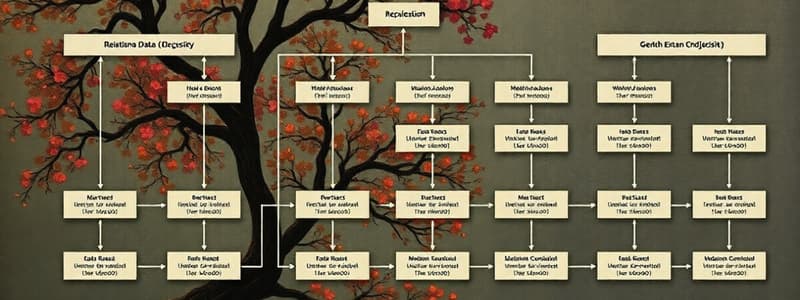Podcast
Questions and Answers
What relationship type describes the connection where many employees can enroll in many trainings and vice versa?
What relationship type describes the connection where many employees can enroll in many trainings and vice versa?
- Many to Many (correct)
- One to Many
- One to One
- Many to One
Which normal form requires that all non-key attributes are fully dependent on the primary key?
Which normal form requires that all non-key attributes are fully dependent on the primary key?
- Second Normal Form (correct)
- Boyce-Codd Normal Form
- Third Normal Form
- First Normal Form
In an ER diagram, how are attributes represented?
In an ER diagram, how are attributes represented?
- Circle
- Oval (correct)
- Diamond
- Rectangle
What aspect does normalization primarily aim to achieve in a database?
What aspect does normalization primarily aim to achieve in a database?
What is represented by a dashed underline in an entity's attributes within an ER diagram?
What is represented by a dashed underline in an entity's attributes within an ER diagram?
What is the first step in the process of creating an ER model?
What is the first step in the process of creating an ER model?
Which normalization form aims to eliminate transitive dependencies?
Which normalization form aims to eliminate transitive dependencies?
What type of database design process specifies tables, fields, data types, and relationships?
What type of database design process specifies tables, fields, data types, and relationships?
What is the main purpose of foreign keys in a relational database?
What is the main purpose of foreign keys in a relational database?
Which of the following statements accurately describes a primary key?
Which of the following statements accurately describes a primary key?
What role do relationships play in maintaining data integrity within a relational database?
What role do relationships play in maintaining data integrity within a relational database?
How do entity relationship diagrams contribute to relational database design?
How do entity relationship diagrams contribute to relational database design?
Which of the following is a benefit of reduced data redundancy in a relational database?
Which of the following is a benefit of reduced data redundancy in a relational database?
What is the significance of efficient data retrieval in relational databases?
What is the significance of efficient data retrieval in relational databases?
In a relational database, how is a table fundamentally structured?
In a relational database, how is a table fundamentally structured?
What does the elimination of data redundancy specifically help to achieve in relational databases?
What does the elimination of data redundancy specifically help to achieve in relational databases?
Flashcards
Relational Database
Relational Database
A database system where data is organized into tables with rows and columns, and relationships between tables are established through primary and foreign keys.
Table
Table
A fundamental building block of a relational database, containing rows (records) and columns (fields). Each table represents a specific entity.
Primary Key
Primary Key
Unique identifiers that define each row in a table.
Foreign Key
Foreign Key
Signup and view all the flashcards
Data Integrity
Data Integrity
Signup and view all the flashcards
Efficient Data Retrieval
Efficient Data Retrieval
Signup and view all the flashcards
Reduced Data Redundancy
Reduced Data Redundancy
Signup and view all the flashcards
Entity Relationship Diagram (ERD)
Entity Relationship Diagram (ERD)
Signup and view all the flashcards
One-to-One Relationship
One-to-One Relationship
Signup and view all the flashcards
One-to-Many Relationship
One-to-Many Relationship
Signup and view all the flashcards
Many-to-One Relationship
Many-to-One Relationship
Signup and view all the flashcards
Many-to-Many Relationship
Many-to-Many Relationship
Signup and view all the flashcards
Normalization
Normalization
Signup and view all the flashcards
1st Normal Form (1NF)
1st Normal Form (1NF)
Signup and view all the flashcards
2nd Normal Form (2NF)
2nd Normal Form (2NF)
Signup and view all the flashcards
3rd Normal Form (3NF)
3rd Normal Form (3NF)
Signup and view all the flashcards
Study Notes
Relational Databases
- Relational databases store related data points in tables
- Tables consist of rows (records) and columns (fields)
- Each table represents a specific entity
- Columns define attributes, rows contain data instances
Relationships
- Essential for linking tables and ensuring data integrity
- Established through keys:
- Primary keys uniquely identify each row in a table
- Foreign keys link a row in one table to a row in another table
Why Relationships Matter
- Data integrity: maintains consistency and accuracy of data
- Prevents invalid data insertion (e.g., linking to a non-existent customer)
- Efficient data retrieval: allows complex queries across multiple tables
- Reduced data redundancy: avoids duplication of data
Entity Relationship Diagrams (ER Diagrams)
- Used for conceptual design in relational databases
- Assists in identifying entities, attributes, and relationships
- Show relationships between entities
Relationship Types
- One-to-one (one entity relates to only one other entity)
- One-to-many (one entity relates to many others)
- Many-to-many (many entities relate to many others – requires an intermediate table)
Normalization
- Organizes data to avoid redundancy and improve efficiency
- Eliminates data redundancy and ensures data integrity
- Uses primary and foreign keys
- Reduces transitive dependencies
Normal Forms
- First Normal Form (1NF): Each column contains atomic values (single words/numbers)
- Second Normal Form (2NF): Eliminates partial dependencies (non-key attributes depend on only part of the primary key)
- Third Normal Form (3NF): Eliminates transitive dependencies (non-key attributes depending on other non-key attributes)
Database Design
- Process of defining database structure, storage, and retrieval mechanisms
- Creates a blueprint for data storage and management
- Includes scheme definition (tables, fields, data types, relationships), normalization (data integrity and redundancy reduction), physical implementation (how the database is stored), and performance optimization (query speed)
Studying That Suits You
Use AI to generate personalized quizzes and flashcards to suit your learning preferences.


